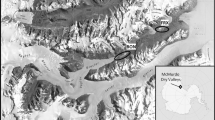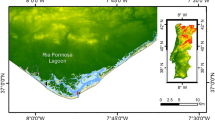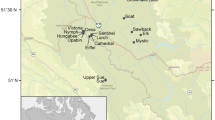Abstract
We used 54 enrichment bioassays to assess nutrient limitation (N, P) of 14C uptake by natural phytoplankton assemblages in 39 lakes and ponds in the Arctic Foothills region of Alaska. Our purpose was to categorize phytoplankton nutrient status in this under-represented region of North America and to improve our ability to predict the response of primary production to anticipated anthropogenically mediated increases in nutrient loading. Experiments were performed across several watersheds and included assays on terminal lakes and lakes occupying various positions in chains (lakes in series within a watershed and connected by streams). In total, 89% (48 of 54) of the bioassays showed significant stimulation of 14C primary production by some form of nutrient addition relative to unamended controls. A significant response was observed following enrichment with N and P, N alone and P alone in 83, 35 and 22% of the bioassays, respectively. In experiments where N and P proved stimulatory, the influence of N alone was significantly greater than the influence of P alone. Overall, the data point to a greater importance for N than P in regulating phytoplankton production in this region. The degree of response to N and P enrichment declined as the summer progressed and showed no relationship to irradiance or water temperature, suggesting secondary limitation by some micronutrient such as iron as the summer advanced. Phytoplankton nutrient status was often consistent across lakes within a watershed, suggesting that watershed characteristics influence nutrient availability. Lakes in this region will clearly show increased phytoplankton production in response to anthropogenic activities and anticipated changes in climate that will increase nutrient loading.
Similar content being viewed by others
References
Aminot, A., D. S. Kirkwood & R. Kérouel, 1997. Determination of ammonia in seawater by the indophenol method: evaluation of the ICES NUTS I/C5 questionaire. Mar. Chem. 56: 59–75.
Axler, R. P., R. M. Gersberg & C. R. Goldman, 1980. Stimulation of nitrate uptake and photosynthesis by molybdenum in Castle Lake, California. Can. J. Fish. Aquat. Sci. 37: 707–712.
Axler, R. P., C. Rose & C. A. Tikkanen, 1994. Phytoplankton nutrient deficiency as related to atmospheric nitrogen deposition in Northern Minnesota acid-sensitive lakes. Can. J. Fish. aquat. Sci. 51: 1281–1296.
Cornwell, J., 1983. The Geochemistry of Manganese, Iron, and Phosphorus in an Arctic Lake. Ph.D. Dissertation, University of Alaska, Fairbanks. 238 pp.
Cornwell, J. C. & G. W. Kipphut, 1992. Biogeochemistry of manganese-and iron-rich sediments in Toolik Lake, Alaska. Hydrobiologia 240: 45–59.
Diaz, M. M. & F. L. Pedrozo, 1996. Nutrient limitation in Andean-Patagonian lakes at latitude 40-41 S. Arch. Hydrobiol. 138: 123–143.
Dillon, P. J. & F. H. Rigler, 1974. The phosphorus-chlorophyll relationship in lakes. Limnol. Oceanogr. 19: 767–773.
Dodds, W. K., K. R. Johnson & J. C. Priscu, 1989. Simultaneous nitrogen and phosphorus deficiency in natural phytoplankton assemblages: theory, empirical evidence, and implications for lake management. Lake Res. Manag. 5: 21–26.
Dodds, W. K. & J. C. Priscu, 1990. A comparison of methods for assessment of nutrient deficiency of phytoplankton in a large oligotrophic lakes. Can. J. Fish. aquat. Sci. 47: 2328–2338.
Elser, J. J. & B. L. Kimmel, 1986. Alteration of phytoplankton phosphorus status during enrichment experiments: implications for interpreting nutrient enrichment bioassay results. Hydrobiologia 133: 217–222.
Elser, J. J., E. R. Marzolf & C. R. Goldman, 1990. Phosphorus and nitrogen limitation of phytoplankton growth in the freshwaters of North America: a review and critique of experimental enrichments. Can. J. Fish. aquat. Sci. 47: 1468–1477.
Galloway, J. N., W. H. Schlesinger, H. Levy, A. Michaels & J. L. Schnoor, 1995. Nitrogen fixation: anthropogenic enhancementenvironmental response. Global Biogeochem. Cycles 9: 235–252.
Goldman, C. R., 1981. Lake Tahoe: two decades of change in a nitrogen deficient oligotrophic lake. Verh. int. Ver. Limnol. 21: 45–70.
Goldman, C. R., A. D. Jassby & S. H. Hackley, 1993. Decadal, interannual, and seasonal variability in enrichment bioassays at Lake Tahoe, California-Nevada, USA. Can. J. Fish. aquat. Sci. 50: 1489–1496.
Hecky, R. E. & P. Kilham, 1988. Nutrient limitation of phytoplankton in freshwater and marine environments: A review of recent evidence on the effects of enrichment. Limnol. Oceanogr. 33: 796–822.
Hershey, A. E., G. Gettel, M. E. McDonald, M. C. Miller, H. Mooers, W. J. O'Brien, J. Pastor, C. Richards & J. A. Schuldt, 1999. A geomorphic-trophic model for landscape control of trophic structure in arctic lakes. Bioscience 49: 887–897.
Hobbie, J. E., B. J. Peterson, N. Bettez, L. Deegan, W. J. O'Brien, G.W. Kling & G.W. Kipphut, 1999. Impact of global change on the biogeochemistry and ecology of an Arctic freshwater system. Polar Res. 18: 1–8.
Hough, R. A. & J. R. L. Thompson, 1996. The influence of a dissolved inorganic nitrogen gradient on phytoplankton community dynamics in a chain of lakes. Hydrobiologia 319: 225–235.
Kalff, J., 1971. Nutrient limiting factors in an arctic tundra pond. Ecology 52: 655–659.
Kratz, T. K., K. E. Webster, C. J. Bowser, J. J. Magnuson & B. B. Benson, 1997. The influence of landscape on lakes in northern Wisconsin. Freshwat. Biol. 37: 209–217.
Lachenbruch, A. H. & B. V. Marshall, 1986. Changing climate: geothermal evidence from permafrost in the Alaskan arctic. Scinece 234: 689–696.
Lean, D. R. S. & F. R. Pick, 1981. Photosynthetic response of lake plankton to nutrient enrichment: A test for nutrient limitation. Limnol. Oceanogr. 26: 1001–1019.
Lebo, M. E., J. E. Reuter, C. R. Goldman & C. L. Rhodes, 1994. Interannual variability of nitrogen limitation in a desert lake: influence of regional climate. Can. J. Fish. aquat. Sci. 51: 862–872.
Markager, S., W. F. Vincent & E. P. Y. Tang, 1999. Carbon fixation by phytoplankton in high Arctic lakes: implications of low temperature for photosynthesis. Limnol. Oceanogr. 44: 597–607.
Mayewski, P. A., W. B. Lyons, M. J. Spencer, M. S. Twickler, C. F. Buck & S. Whitlow, 1990. An ice-core record of atmospheric response to anthropogenic sulphate and nitrate. Nature 346: 554–556.
McCarthy, J. J., W. R. Taylor & J. L. Taft, 1977. Nitrogenous nutrition of the phytoplankton in the Chesapeake Bay. I. Nutrient availability and phytoplankton preferences. Limnol. Oceanogr. 22: 996–1011.
McCoy, G. A., 1983. Nutrient limitation in two arctic lakes, Alaska. Can. J. Fish. aquat. Sci. 40: 1195–1202.
Miller, M. C., G. R. Hater, P. Spatt, P. Westlake & D. Yeakel, 1986. Primary production and its control in Toolik Lake, Alaska. Arch. Hydrobiol. 74: 97–131.
Mitamura, O. & Y. Saijo, 1985. Urea metabolism and its signi-ficance in the nitrogen cycle in the eutrophic layer of Lake Biwa. I. In situ measurement of nitrogen assimilation and urea decomposition. Arch. Hydrobiol. 107: 23–51.
Mitchell, J. F. B., S. Menabe, T. Tokioka & V. Meleshko, 1993. Equlibrium climate change. In Houghton, J. T., G. J. Jenkins & J. J. Ephraums (eds), Climate Change: The IPCC Scientific Assessment, Cambridge University Press, Cambridge: 131–172.
Morris, D. P. & W. M. Lewis, 1988. Phytoplankton nutrient limitation in Colorado mountain lakes. Freshwat. Biol. 20: 315–327.
O'Brien, W. J., A. E. Hershey, J. E. Hobbie, M. A. Hullar, G. W. Kipphut & M. C. Miller, 1992. Control mechanisms of arctic lake ecosystems: a limnocorral experiment. Hydrobiologia 240: 143–188.
Paerl, H., 1997. Coastal eutrophication and harmful algal blooms: importance of atmospheric deposition and groundwater as 'new' nitrogen and other nutrient sources. Limnol. Oceanogr. 42: 1154–1165.
Parsons, T. R., Y. Maita & C. M. Lalli, 1984. A Manual of Chemical and Biological Methods for Seawater Analysis. Pergamon, Oxford. 173 pp.
Ping, C. L., J. G. Bockheim, J. M. Kimble, G. J. Michaelson & D. A. Walker, 1998. Characteristics of cryogenic soils along a latitudinal transect in Arctic Alaska. J. Geophys. Res. 103: 28917–28928.
Priscu, J. C., 1995. Phytoplankton nutrient deficiency in lakes of the McMurdo dry valleys, Antarctica. Freshwat. Biol. 34: 215–227.
Rae, R. & W. F. Vincent, 1998. Phytoplankton production in subarctic lake and river ecosystems: development of a photosynthesistemperature-irradiance model. J. Plankton Res. 20: 1293–1312.
Reuter, J. E., C. L. Rhodes, M. E. Lebo, M. Kotzman & C. R. Goldman, 1993. The importance of nitrogen in Pyramid Lake (Nevada, USA), a saline, desert lake. Hydrobiologia 267: 179–189.
Rowntree, P. R., 1997. Global and regional patterns of climate change: Recent prediction for the Arctic. In Oechel, W. T., T. V. Callaghan, T. Gilmanov, J. I. Holten, B. Maxwell, U. Molau & B. Sveinbjornssön (eds.), Global Change and Arctic Terrestrial Ecosystems, Springer, NY: 106–113.
Schindler, D.W., 1977. Evolution of phosphorus limitation in lakes. Science 195: 260–262.
Schindler, D. W., 1978. Factors regulating phytoplankton production and standing crop in the world's freshwaters. Limnol. Oceanogr. 23: 478–486.
Schindler, D. W., 1988. Experimental studies of chemical stressors on whole lake ecosystems. Verh. int. Ver. Limnol. 23: 11–41.
Shaver, G. R., K. J. Nadelhoffer & A. E. Giblin, 1991. Biogeochemical diversity and element transport in a heterogeneous landscape, the North Slope of Alaska. In Turner, M. G. & R. H. Gardner (eds), Quantitative Methods in Landscape Ecology. Ecol Stud. 82, Springer, Berlin: 105–125.
Stumm, W. & J. J. Morgan 1996. Aquatic Chemistry: Chemical Equilibria and Rates in Natural Waters. John Wiley & Sons, Inc., New York. 1022 pp.
Suttle, C. A. & P. J. Harrison, 1988. Ammonium and phosphate uptake rates, N:P supply ratios, and evidence for N and P limitation in some oligotrophic lakes. Limnol. Oceanogr. 33: 186–202.
Taylor, D., S. Nixon, S. Granger & B. Buckley, 1995. Nutrient limitation and the eutrophication of coastal lagoons. Mar. Ecol. Prog. Ser. 127: 235–244.
Turpin, D. H., I. R. Elrifi, D. G. Birch, H. G. Weger & J. J. Holmes, 1988. Interactions between photosynthesis, respiration and nitrogen assimilation in microalgae. Can. J. Bot. 66: 2083–2097.
Twiss, M. R., J.-C. Auclair & M. N. Charlton, 2000. An investigation into iron-stimulated phytoplankton productivity in epipelagic Lake Erie during thermal stratification using trace metal clean techniques. Can. J. Fish. Aquat. Sci. 57: 86–95.
Vincent, W. F. & C. L. Vincent, 1982a. Response to nutrient enrichment by the phytoplankton of Antarctic coastal lakes and the inshore Ross Sea. Polar Biol. 1: 159–165.
Vincent, W. F. & C. L. Vincent, 1982b. Factors controlling phytoplankton production in Lake Vanda (77S). Can. J. Fish. Aquat. Sci. 39: 1602–1609.
Vincent, W. F., W. Wurtsbaugh, C. L. Vincent & P. J. Richerson, 1984. Seasonal dynamics of nutrient limitation in a tropical high-altitude lake (Lake Titicaca, Peru-Bolivia): Application of physiological bioassays. Limnol. Oceanogr. 29: 540–552.
Vollenweider, R. A., 1976. Advances in defining critical loading levels of phosphorus in lake eutrophication. Mem. Ist. Ital. Idrobiol. 33: 53–83.
Wahrhaftig, C., 1965. Physiographic divisions of Alaska, US Geol. Surv. Prof. Pap. 482, US Gov. Print. Off., Washington, DC.
Walker, M. W., D. A. Walker & N. A. Auerback, 1994. Plant communities of tussock tundra landscape in the Brooks Range Foothills, Alaska. J. Vegetat. Sci. 5: 843–866.
Wetzel, R. G. & G. E. Likens, 1991. Limnological Analyses. Springer, New York, 391 pp.
Whalen, S. C. & V. Alexander, 1986a. Chemical influences on 14C and 15N primary production in an arctic lake. Polar Biol. 5: 211–219.
Whalen, S. C. & V. Alexander, 1986b. Seasonal inorganic carbon and nitrogen transport by phytoplankton in an arctic lake. Can. J. Fish. aquat. Sci. 43: 1177–1186.
Whalen, S. C. & J. R. Cornwell, 1985. Nitrogen, phosphorus, and organic carbon cycling in an Arctic lake. Can. J. Fish. aquat. Sci. 42: 797–808.
Whalen, S. C. & J. R. Cornwell, 1988. Comparison of chemical and biological N budgets in an arctic lake: implications for phytoplankton production. In Degens, E. T., S. Kempe & A. S. Naidu (eds), Transport of Carbon and Minerals in Major World Rivers, Lakes and Estuaries. Mitt. Geol. Palaont. Inst. Univ. Hamburg, SCOPE/UNEP, 66: 99–115.
White, E. & G.W. Payne, 1977. Chlorophyll production, in response to nutrient additions, by the algae in Lake Taupo water. New Zealand J. mar Freshwat. Res. 11: 501-507.
White, E., K. Law, G. Payne & S. Pickmere, 1985. Nutrient demand and availability among planktonic communities-an attempt to assess nutrient limitation to plant growth in 12 central volcanic plateau lakes. New Zealand J. mar Freshwat. Res.19: 49–62.
Author information
Authors and Affiliations
Corresponding author
Rights and permissions
About this article
Cite this article
Levine, M., Whalen, S. Nutrient limitation of phytoplankton production in Alaskan Arctic foothill lakes. Hydrobiologia 455, 189–201 (2001). https://doi.org/10.1023/A:1011954221491
Issue Date:
DOI: https://doi.org/10.1023/A:1011954221491




